6. Some Survive, Few Are Conserved, Even Fewer Can Travel: Paradoxes and Obstacles in Maintaining and Staging Biomedia Art
- Jens Hauser
The creation of lifelike appearances is a persistent feature in art, from early anthropomorphic statues and myths of artists’ works “coming to life,” to notions of the artwork as an organism in itself, to robotic and software simulations of digital media art, to, more recently, artistic artifacts created in bioscientific contexts. By means of form, material, or process, art has imagined, represented, mimicked, simulated, and quite recently actually manipulated living beings and systems, since genetics, tissue engineering, DNA chips, and so-called synthetic BioBricks have entered the repertoire of experimental artistic strategies—for which cultural institutions remain dramatically ill-equipped.
Three primary typologies of “alive” artworks exist today: representational and concept-based art, often including organic matter; process-based “dry” media art using software and hardware such as informatics and robotics to simulate lifelike behaviors via media that are not biological; and process-based “moist” media art with wetware that uses biotechnological methods to manipulate organic systems, organisms, or their constitutive parts in an aestheticized technical framework.
The first category includes the use of biological materials such as bodily fluids, food, or intentional putrefaction processes in an attempt to attribute semantic value to unstable materials. The potentially fragile works are likely to pose serious challenges for display and shipping, but above all for preservation. However, a large part of these issues can be solved through established best practices of conservation treatment that claim “universal applicability”—for example, a methodology that consists of first characterizing an object, including its history and ideal state, followed by the creation of a realistic treatment goal accompanied by complete documentation of all steps (, xxii, xix).
The second category can be addressed according to methodologies for preservation and reenactment of performative, digital, or time-based media art. These have been recently developed as the urgency of conserving and collecting technological art has been recognized. Here, software and hardware conservation, accompanied by artist interviews, are key when faced with rapid technological obsolescence, deterioration, and future incompatibility. Process- and communication-based art, often with expanded concepts of artistic authorship, “reduce the hitherto valid collecting criteria of longevity, authenticity, and intrinsic value to absurdity” (, 24).
Devoid of institutional advocacy, the third category lacks any coordinated methodology, since these practices cut across many disciplines, from art to natural history, medical, and design museums, media art and performance festivals, biotechnology and bioethics, and are still only supported by a few collectors ready to engage with the subsequent challenges beyond conservable objects. Some of the challenges of biomedia art present similarities to those of performance art—especially as their actual presence may not only be reenacted but “survive” in the form of documents or physical remnants (). However, the various nonhuman and techno-scientific agencies of micro-performativity (; ) involved in such artworks destabilize human scales (both spatial and temporal) as the dominant plane of aesthetic experience and link together the machinic and the organic (). The shift from organic representation to biological manipulation results in technical, institutional, regulatory, legal, ethical, bureaucratic, philosophical, and aesthetic issues with regard to museum infrastructures, the status of living organisms, tissues, and genetically modified organisms (GMOs), and their fragility when maintaining, conserving, reenacting, or shipping them.
Interestingly, the first reported historical case of genetically modified organisms exhibited as artwork in a major museum already anticipated the entanglement of today’s challenges. In 1936, at New York’s Museum of Modern Art, photographer Edward Steichen showed hundreds of living delphinium plants that he had bred and altered with colchicine, drawing parallels between the authentic aliveness of his photography and flower breeding. The exhibition followed his motto “art for life’s sake”; the museum “reduced to showing ‘art for art’s sake,’ to Steichen . . . [was] a mausoleum” (, 353). Steichen drove the blooms to MoMA in a refrigerated truck, and the display during the eight-day show needed to be occasionally refurbished. The museum took care to “avoid confusion; it should be noted that the actual delphiniums will be shown in the museum, not paintings or photographs of them” ().
The artist’s desire to see purposeful genetic mutation applied to plant breeding recognized as art seems to be correlated with shipping and customs issues he had previously encountered. It is reported that Steichen was involved in an exhibition at MoMA for which he shipped Constantin Brâncuși’s Bird in Space (1923), which was refused both duty-free entry into the United States and status as a work of art because of its lack of representative qualities, since “no feathers were visible” (, 350). Steichen’s battle against the $600 penalty is therefore to be seen as a part of a larger battle to redefine aesthetics. However, his delphiniums were not for sale as art “objects,” and his MoMA works “survived” as unsalable photo documentation only before they later appeared beyond the confines of the art market, in the form of commercially available, affordable seed packs under the name Delphinium Steichen strain mix.
Half a century later, Steichen has been rediscovered and rehabilitated as the precursor of biotechnological art by George Gessert, a painter who exchanged brushes for genetic plant hybridization in the early 1980s. In his installations of “inverted Darwinism,” Gessert selects plants diametrically opposed to dominant aesthetics and the “laws” of the market. But in the age of molecular genetics and after the horrors of World War II’s human experimentations, his arrangements trigger, behind their facade of beauty, reflections on eugenics and genetic selection driven by politics or fashion (). Downplaying human centrality, he acknowledges “insects and wind” as equal nonhuman co-creators (fig. 6.1), and insists on keeping his seeds “out of the marketplace” and away from art collectors.1 Instead, for him the “art to scatter” consists of inserting his hybrids into the ecological cycle: sowing seeds, sending pollen or plants to people, or transplanting them at unexpected urban or wilderness places ().
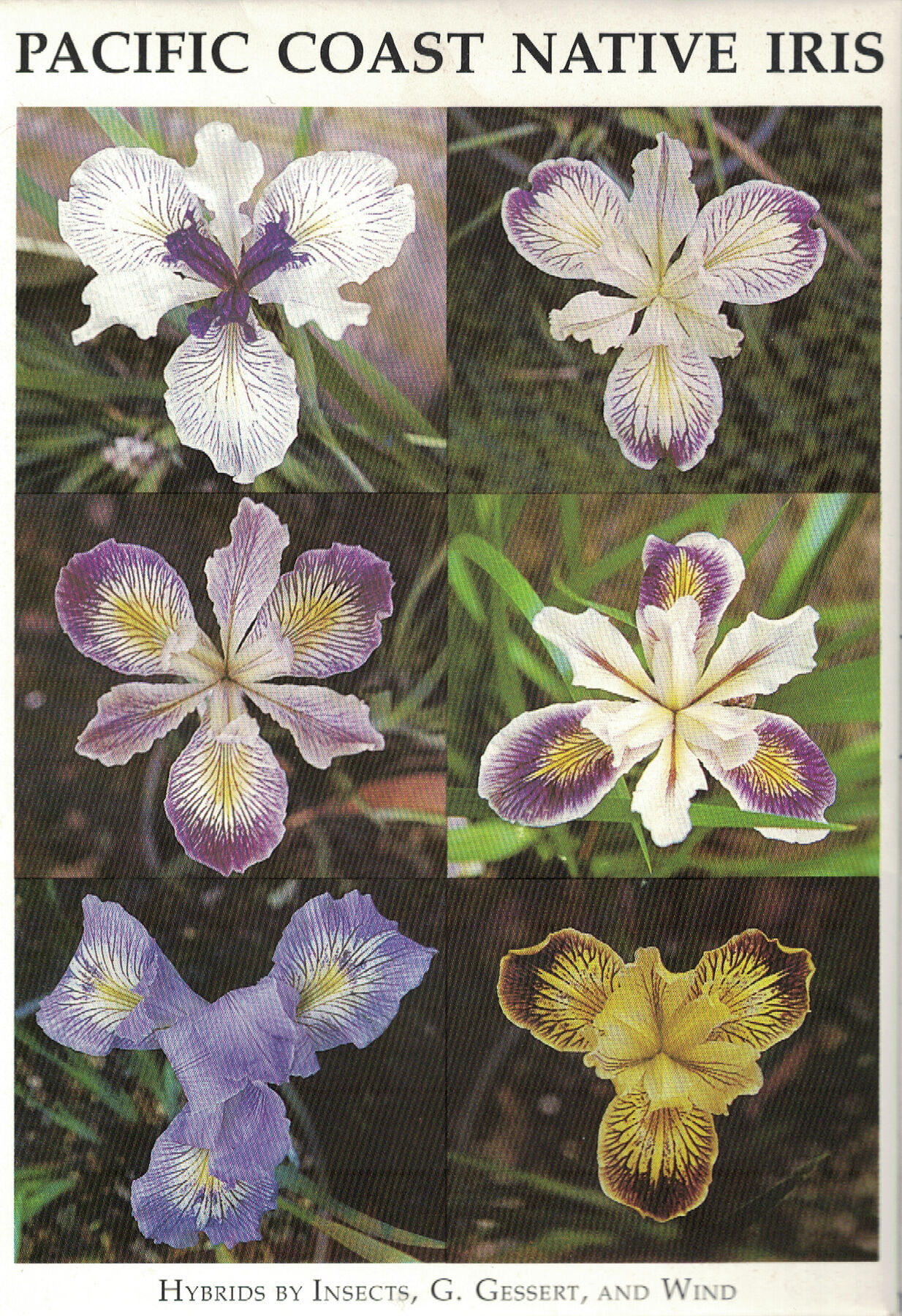 Figure 6.1
Figure 6.1Despite the formal similarities, significant changes have occurred with the general shift from objecthood to process-based art linked to the cybernetic paradigm in the second half of the twentieth century. Lucy Lippard described a phenomenon she called the “dematerialization of the art object” whereby a greater focus is placed on conceptual artistic thought and processes rather than on collectible objects (). Similarly, Jack Burnham’s Beyond Modern Sculpture (1968) aptly anticipates what biomedia art will become in an era of technical media competence, interest in scientific insights, awareness of ecosystems, and the desire to biotechnically create “aliveness.” Burnham examines the evolution of sculpture over the last twenty-five hundred years and states that art’s survival depends on its transition “from a psychically-impregnated totemic object toward a more literal adaptation of scientific reality via the model or technologically inspired artefact,” then to “life-simulating systems through the use of technology” and “away from biotic appearances toward biotic functioning via the machine” (, 76). Influenced by cybernetics, environmental concerns, and Ludwig von Bertalanffy’s systems biology (), Burnham hoped that such art would encourage spectators to adopt a holistic view and develop environmental consciousness—not contra but qua technology. It is unlikely, however, that he anticipated the incredible variety of biotechnology-based art today, and all its consequences for staging, conservation, and transport (fig. 6.2).
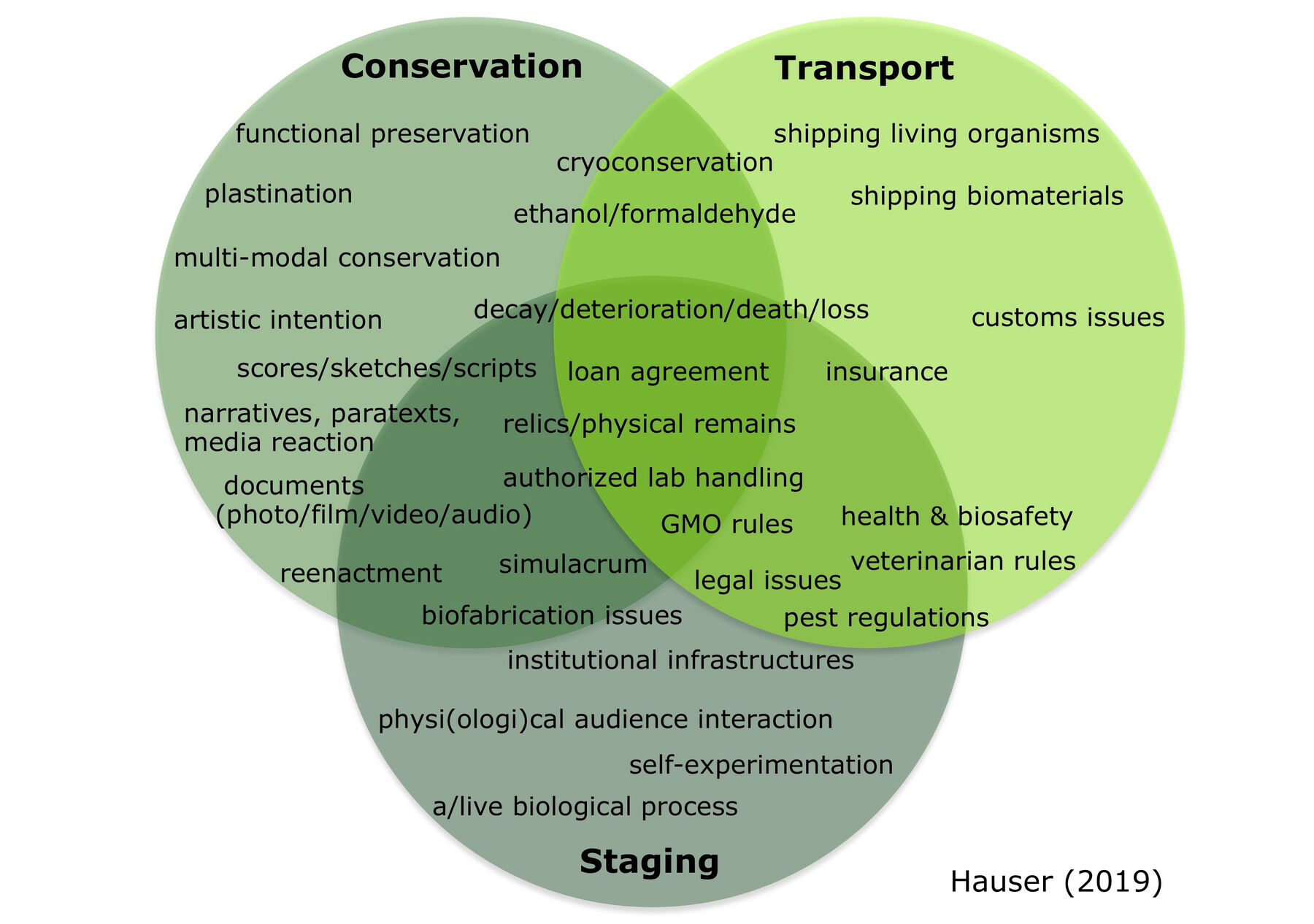 Figure 6.2
Figure 6.2An ideal-case scenario in which a work of biomedia art may be seamlessly shipped and staged alive, and be functionally conserved in its potential to be reenacted whenever needed, is the rare exception. From a curatorial standpoint, this means that a large part of exhibition budgets is dedicated to regrowing potentially rotting and fragile ephemerals and facilitating a greater number of artist visits, since works constantly face the threat of contamination, deterioration, or death. Diligent curatorial work requires time and effort be spent negotiating specific local laboratory infrastructures, sometimes more than a year in advance, endless legal and bioethical paperwork, perpetual shipping and customs problems, and manifold technical, ethical, and legal challenges to maintain literally alive art.
Staging biomedia art is, technically, most challenging when artists insist that their work has to be shown alive. This often overexerts, and sometimes voluntarily challenges, the museum’s ability to provide the needed infrastructure for works that fall outside standard display methods. Regular care and maintenance by specially trained assistants is necessary. In addition, the health and safety and ethics regulations for the public display of materials such as tissues or GMOs are not the same in every country. Living organisms are sometimes euthanized by museums after an exhibition against the artist’s will in order to comply with animal health inspection and quarantine rules—even after organizing gallery talks that glorify interspecies empathy. Legally, some works may even be shown only “in transit” on their way to authorized labs. Common practices such as loan agreements or condition reports encounter obstacles when the work consists largely of ephemeral, living, or perishable entities and customized or borrowed laboratory equipment. At the same time, these institutional limitations push artists to consider showing simulacra, documentation, or remnants instead of the actual “alive” artwork.
Conservation of art that deals with the manifold characteristics of the living, such as metabolism, growth, reproduction, or mutation, unfolds per se as paradoxical. Functional preservation of works may be possible in cases where the artist establishes precise protocols for reenactment. However, an ongoing debate among protagonists in the field is whether a biological entity should be preserved, plastinated, or taxidermied after its performative display. Instead of the actual artwork, documentation, scores, sketches, and other mediated paratexts are increasingly deployed and produced by artists aware of institutional constraints (). In some cases, technical solutions are conceived for collectors to preserve the work’s apparent “aliveness” even in the event of its biological death.
The transport of such works—including actual organisms, organic matter, or biological samples such as genetic sequences, plants, or tissue—can often not be handled by regular art shippers. Instead biomedical companies must transport them from lab to lab. Additionally, customs declarations may require different details to be reported when such art travels across international borders, conforming to national policies in regard to biodiversity, ethics, veterinary, phyto-sanitary, or pest regulations. The following short case studies illustrate some of these issues and solutions.
A striking example of how GMO regulations affect biomedia art differently, even across countries within the otherwise homologized space of the European Union and associated countries, is Jun Takita’s bioluminescent sculpture Light, only light (2003). The work is meant to be experienced by visitors in total darkness, and consists of a 3D print of the artist’s brain covered with moss containing a genetic sequence from the firefly. Confronting the viewer with a light-emitting plant, materializing the historical association of light with life, Takita presents the transgenic as an ambiguous cognitive achievement of the human brain. The brain shape is strongly reminiscent of skull motifs seen in vanitas and memento mori paintings. Initially developed as a fully functioning version, perceivable with the naked eye, for the exhibition sk-interfaces at FACT art center, Liverpool (), thousands of pounds and many months were spent developing the piece with a team of Japanese scientists and a supporting lab in Leeds. After discussions with the UK Department for Environment, Food and Rural Affairs, and just a week before the opening, the art center reconsidered the artwork. Despite being double-contained in a specially built Plexiglas case and displayed in a closed gallery, potential release of spores into the environment could not be 100 percent excluded “in the event of a systems failure.” And although given that “the chance is slight and that if such an event were to occur it would constitute a category 1 (low) release,” this was a risk they were unwilling to take.2 As a result, sk-interfaces only included a non-glowing, non-GMO simulacrum—a fact disclosed to audiences.
A few months later, however, a fully functional version of Light, only light made its debut as part of the Article Biennale in Stavanger, Norway (fig. 6.3).3 Here, the glowing brain sculpture was shown in the lantern room as the only form of illumination at a coastal lighthouse, where visitors were invited in to contemplate the stunning effect. This time, the organizers had decided to operate in a legal gray zone by displaying Light, only light “in transit.” A permit for contained use of genetically modified plants was obtained with the condition that the transgenic moss, after having been sent from Leeds to a laboratory in Uppsala, Sweden and driven over the border by the artist himself, would be autoclaved at a laboratory at the University of Stavanger.
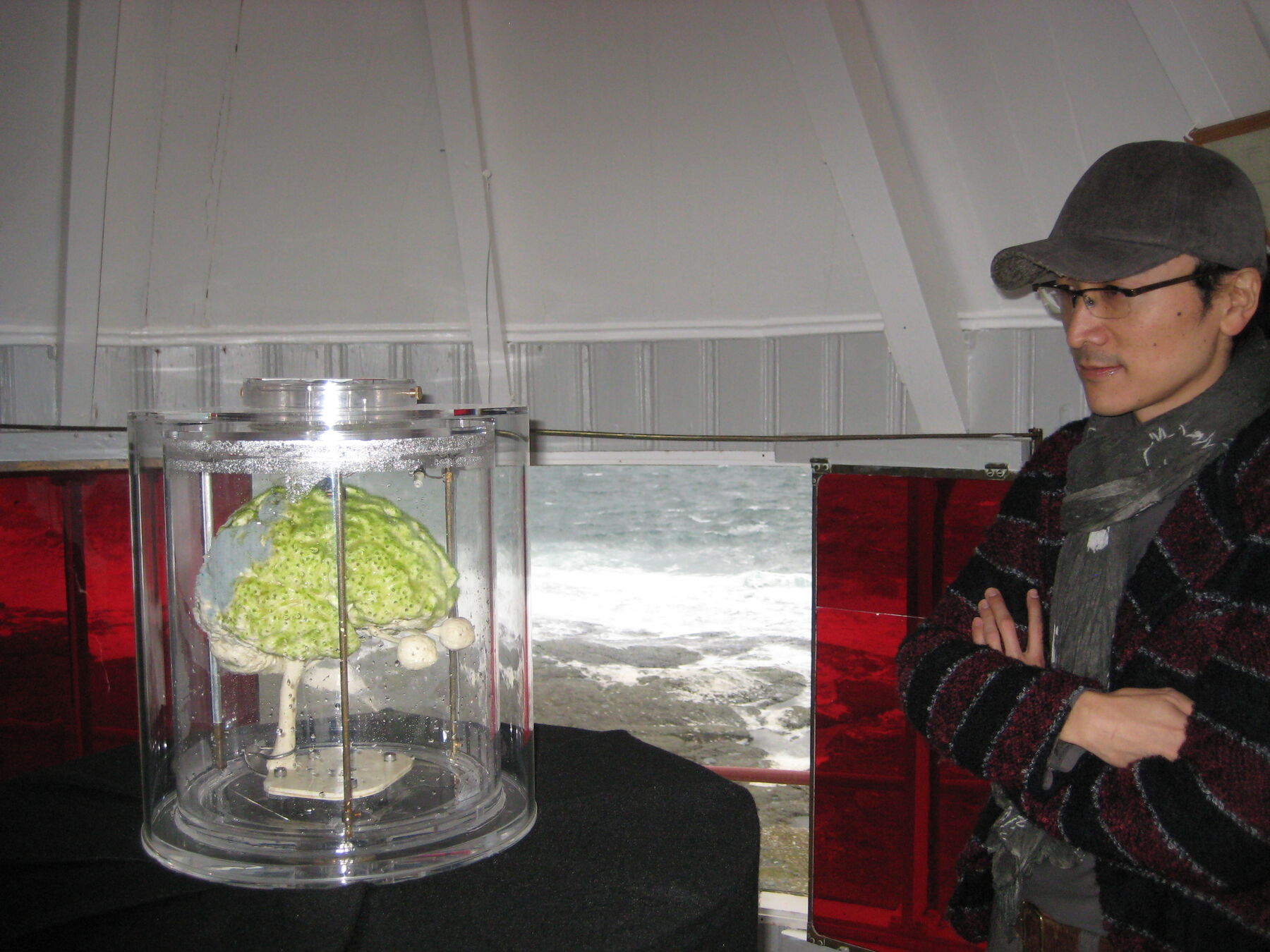 Figure 6.3
Figure 6.3And finally, no regulatory issues at all occurred during the next venue of the sk-interfaces exhibition, Casino Luxembourg. In close coordination with that country’s Ministry of the Environment and taking the issue seriously several months before the opening, the venue deemed Takita’s piece as not presenting any danger of unintended release, and organized popular weekly demonstrations of the moss glowing in a specially constructed gallery room.
Luxembourg’s decision might have been influenced by a precedent: the official authorization obtained for another transgenic art piece to be shown at the same exhibition: Eduardo Kac’s Natural History of the Enigma (2009). This work involves the creation of a transgenic “plantimal” by combining human and plant DNA to produce a genetically engineered flower: a molecular hybrid of the artist himself and a petunia, called Edunia. In this new strain, the artist’s DNA extracted from his blood produces a human protein in the red veins of the flower. Ironically, the actual plant could not be displayed at Casino Luxembourg either, only as photographic representation. While all applications to Luxembourg’s state authorities regarding the import of genetically modified organisms and phyto-sanitary risk management were successful, the flower was ultimately not shipped. The Weisman Art Museum at the University of Minnesota, Minneapolis, which commissioned the work, claimed a last-minute loan fee of $3,500 to $4,000 to prepare paperwork and packing for the loan, in addition to the pretense “that the usual lead time needed for us to approve a loan is at least twelve months prior to the opening.”4
It is understandable that artists who struggle for their work to be shown alive mock museums’ inefficiencies to provide the required infrastructure and increasingly conceive of their participation in large exhibitions as deliberate institutional critique. A recent example shows how the Tissue Culture & Art Project, a protagonist of biomedia art for the last two decades, challenged the Centre Pompidou in Paris by staging work that brands museums as the ultimate necropolis. Referencing Samuel Butler’s Erewhon (), their piece (for art is like a living organism). . . Better Dead Than Dying (2014, fig. 6.4) consists of a closed bioreactor where cancerous HeLa cells grow a miniature figurine shaped after Henrietta Lacks, the person from whom this cell line originated (). However, the bioreactor is specifically designed with limited nutrients and without a waste removal system, so that it becomes, purposefully, a death chamber. Tissue Culture & Art Project cofounder Oron Catts explained the ironic design of the piece included in the 2019 La Fabrique du vivant show as a reaction to previous correspondence, revealed in public, with Centre Pompidou’s curators: “I am afraid it would be difficult to realize a living installation work as part of the show Designing the Living at the Centre Pompidou.”5
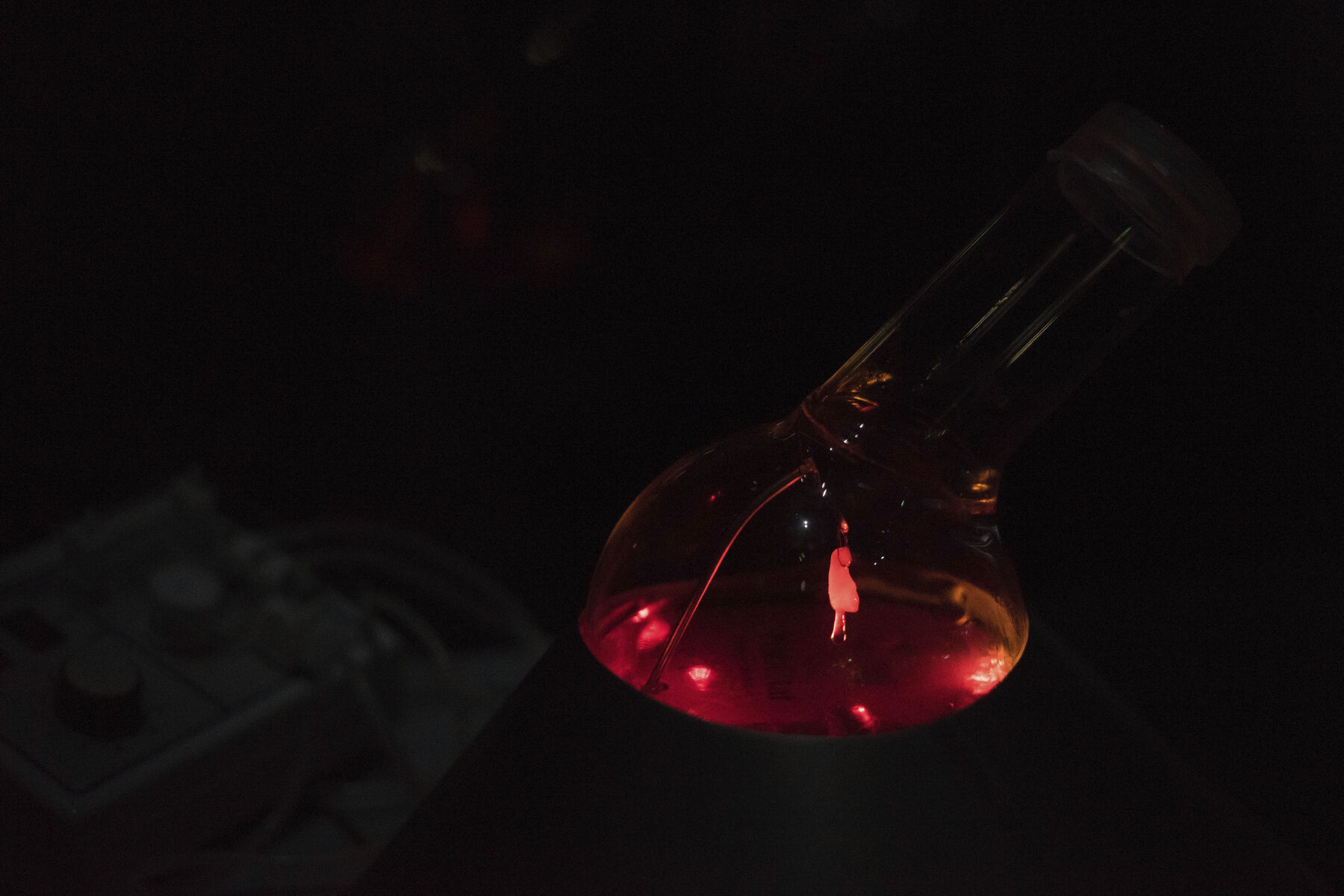 Figure 6.4
Figure 6.4Another piece by the Tissue Culture & Art Project, Victimless Leather (2004), sparked headlines like “Murder at MoMA?” when the bioreactor growing miniature leather-like jackets out of immortalized animal and human cell lines had to be stopped due to unforeseen cell proliferation taking over the apparatus in MoMA’s Design and the Elastic Mind show (). While the art died a month into the exhibition, the institution turned the failure to stage the piece as intended into a popular selling narrative. Victimless Leather was indeed performed successfully just before and after the MoMA exhibition at sk-interfaces in Liverpool and Luxembourg. Here, the question of the “afterlife” of the grown biotechnological garments was debated between the artists and the curator, resulting in the decision to have the surviving cell cultures plastinated (fig. 6.5), but to keep them strictly for documentation purposes—neither exhibit them in place of the actual piece, nor sell them.
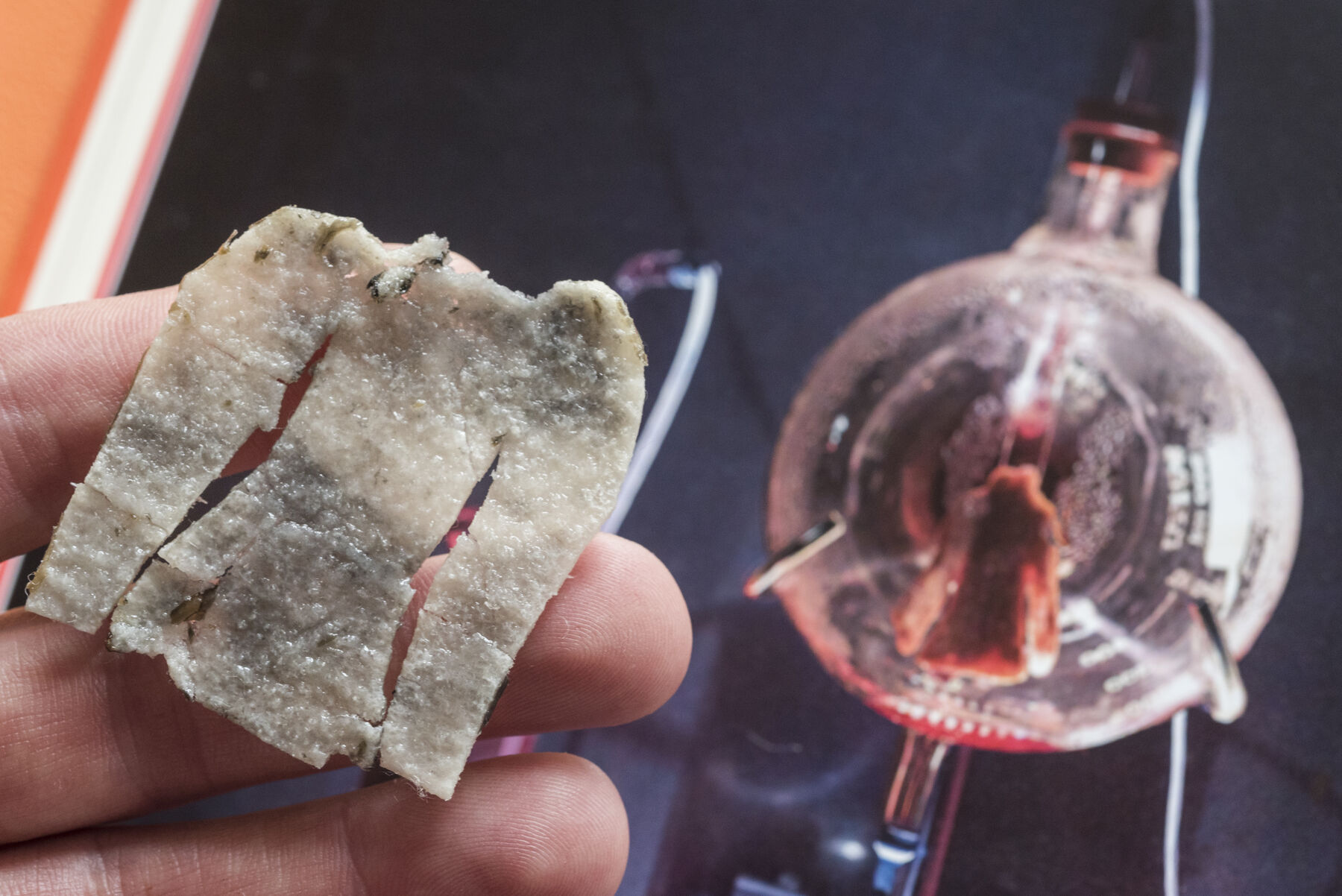 Figure 6.5
Figure 6.5In contrast, artist Brandon Ballengée has found a way to both carry out bio-artistic research and preserve material outcomes that can be collected. In Species Reclamation via a Non-linear Genetic Timeline (1998–2006, fig. 6.6, fig. 6.7) he aims at phenotypically re-creating an extinct aquatic frog species using closely related extant species by resurfacing historically described physical traits, resulting in “living sculptures” (). They live their natural life span before being cleared and stained (a chemical process to reveal the animal’s skeletal anatomy consisting of bones and cartilage), photographed, and sold as prints or as conserved specimens, ready to be released into glycerin, where their translucent members seem to gracefully swim.
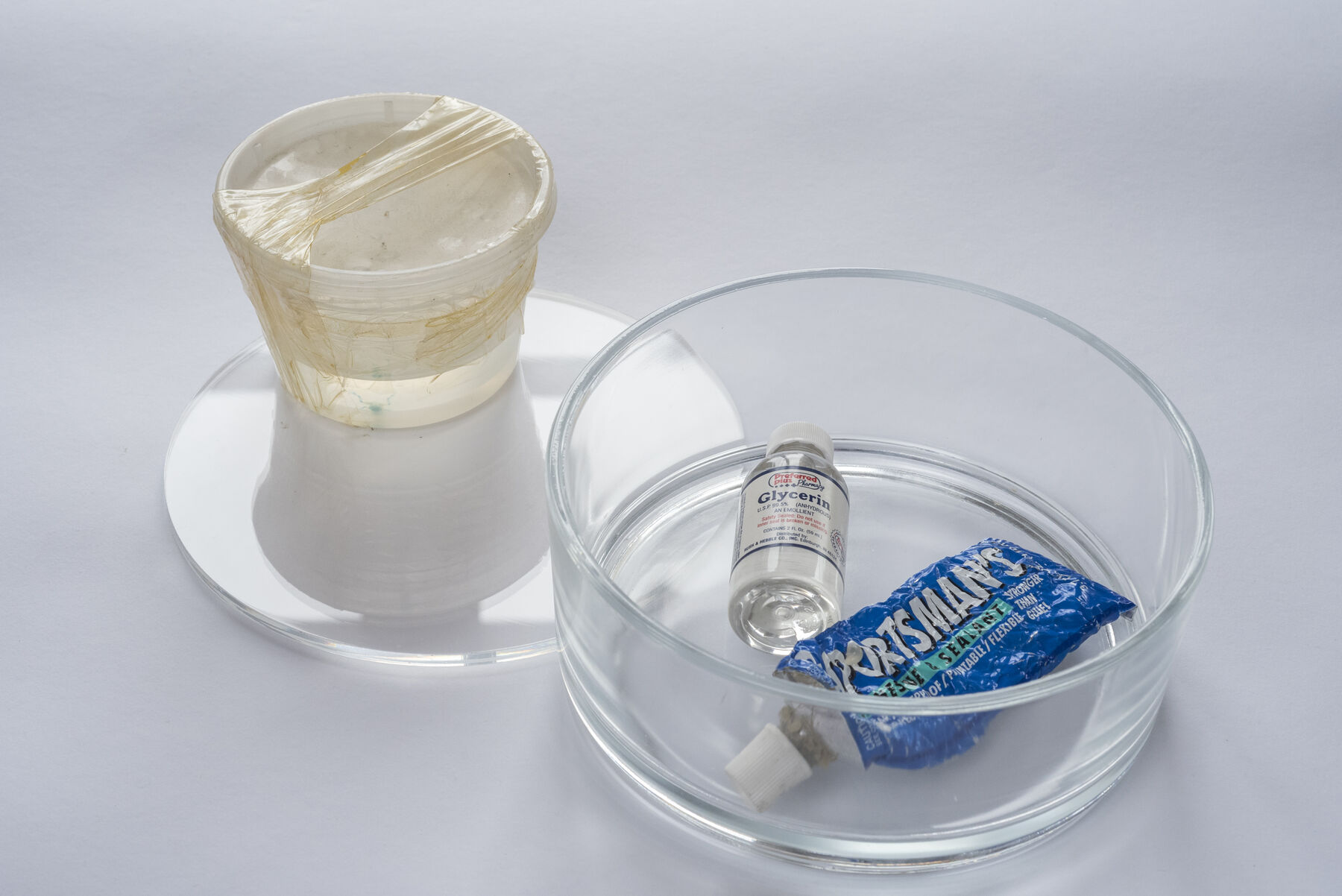 Figure 6.6
Figure 6.6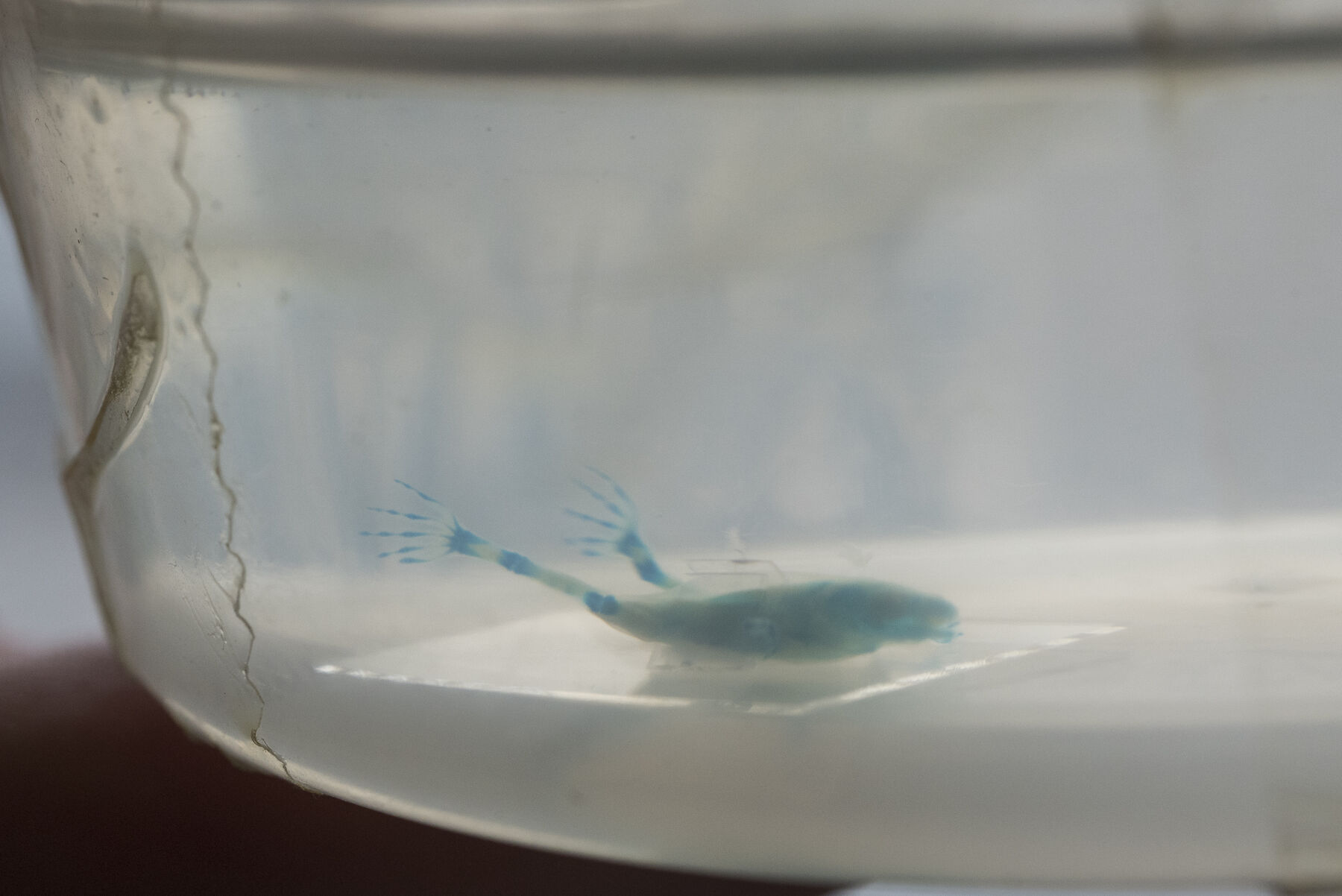 Figure 6.7
Figure 6.7An exemplary case of conservation of a complex synthetic biology-based work is Living Mirror (2013, fig. 6.8) by the artist duo C-Lab, which solves the challenge of optimizing a living biomedia piece so its function is preserved in potential perpetuity. Living Mirror uses magnetotactic bacteria’s ability to swim along the Earth’s magnetic field in order to create a living mirror image of the silhouette of its observer. Once an input image is translated into a magnetic field, the bacteria reorient their bodies in real time, causing light to scatter and create an image in a liquid bacteria culture. The piece draws on the myth of Narcissus, who fell in love with his own image in the water’s reflection, and at the same time emphasizes contemporary science’s discovery that human bodies are made up of a majority of nonhuman bacterial cells. The development of a collectible version in which this shimmer effect persists over time took several years—with bottles available for replacement in case of anomalies. Even if the bacteria die, whatever nanomagnetic chain they created would remain intact beyond their death.
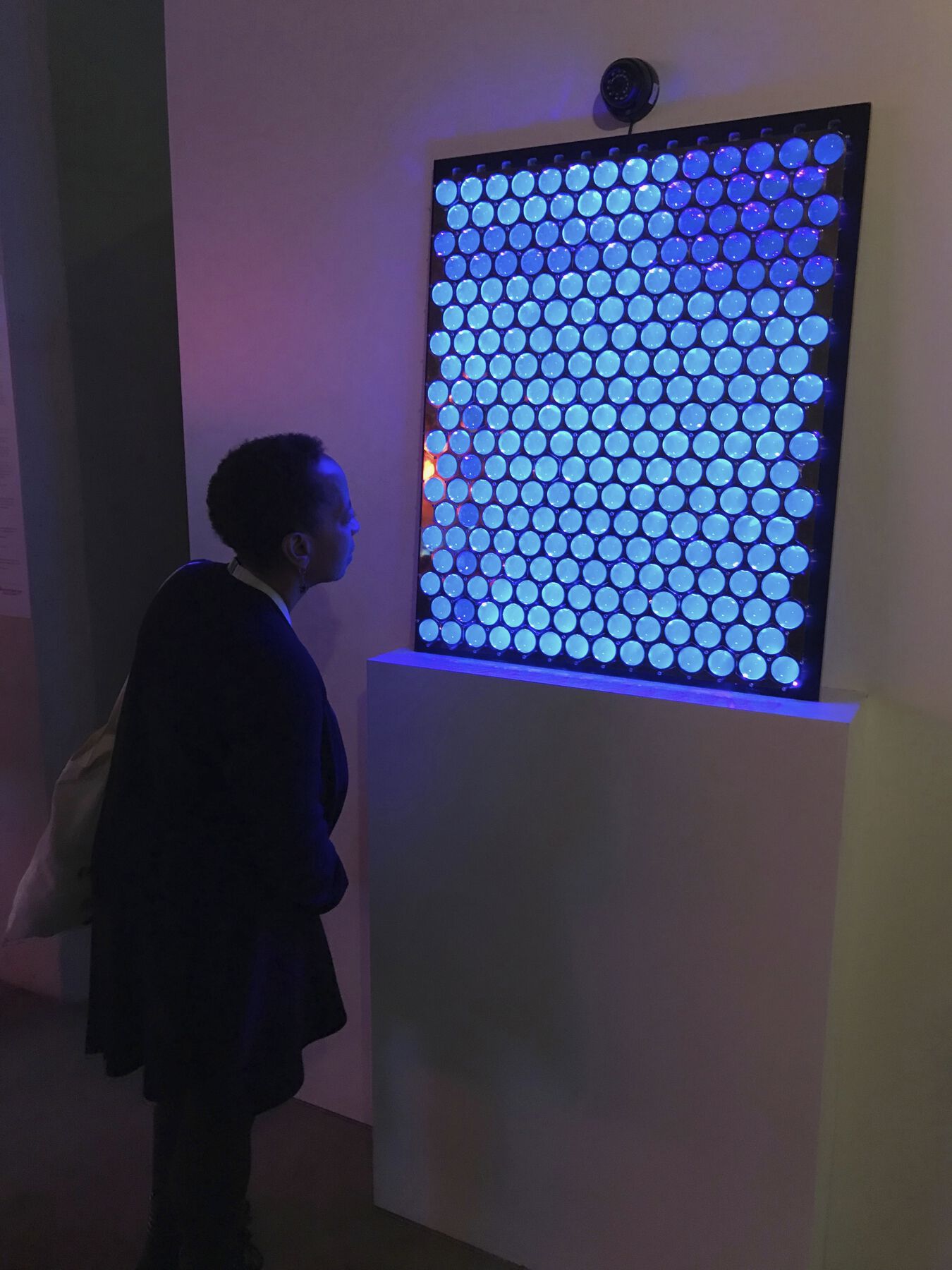 Figure 6.8
Figure 6.8An early art piece involving tissue culture, Art Orienté Objet’s Artists’ Skin Cultures (1996, fig. 6.9), is curious with regard to conservation and transportation issues. Initially grown out of the artists’ epidermal cells grafted onto pig dermis and tattooed with motifs of lab model organisms and endangered species, these trans-species totems were supposed to be offered for grafting to collectors, but were finally conserved in formaldehyde and sold. Ironically, although the pieces were made in the United States in 1996, they could not be shipped back from France for the MATTER(S) matter(s): Bridging Research in the Arts and Sciences show at the Eli and Edythe Broad Art Museum at Michigan State University, Lansing, in 2018. Since formaldehyde is flammable, no art shipper agreed to take this on, and companies specializing in shipping biological samples refused to transport the work due to its hybrid human-animal nature. This necessitated applying for a special permit from the US Department of Agriculture and involved a monthslong process. Previously, when shipping the work to Australia, a workaround was created whereby the customs declarations contained different descriptions on the way in and out: while “pig cells” were disguised under more generic “human and animal cells” on the way to Australia, only cells labeled “domestic pigs” were sent back to France, since shipping human cells would have caused legal complications.
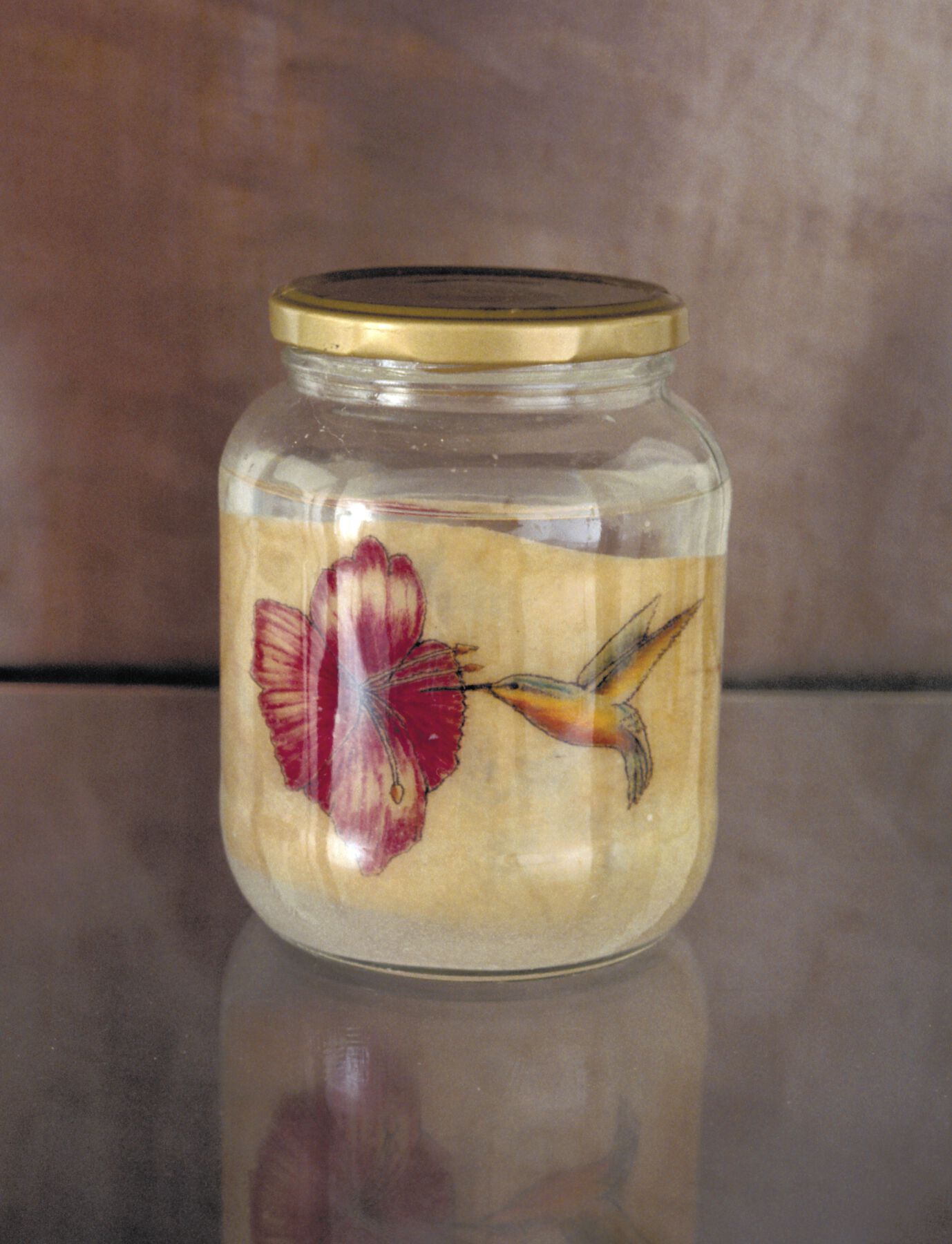 Figure 6.9
Figure 6.9The worst-case scenario consists of loss or theft during transport resulting from the use of companies not specialized in art shipping nor offering adequate insurance coverage. Take Tagny Duff’s Cryobook Archives (2010) as such an example. The Cryobook Archives are frozen sculptures made of human skin. It takes weeks to prepare the packages to meet international shipping standards for biological samples, and they can only be shipped from lab to lab as research items. Since no art shipper was willing to transport living biological samples on dry ice, as required for this work, the pieces were shipped via FedEx from Canada to France and simply disappeared in transit. While the box with the dry ice arrived, all the fleshy sculptures were missing without any explanation (they had last been tracked at the FedEx hub in Memphis). The artist speculated that maybe “an underpaid chain worker believed this to be a precious organ, worth thousands of dollars on the black market,” or that “customs or state authorities considered the art piece to be suspicious and infectious.”6
The difficulties with regard to staging, conservation, and transport should not, however, be treated as a straightforward grid of practical problems to solve in order to enable museums to stage new “living images.” The conceptual challenges are philosophically most inspiring and point as much to profound changes in contemporary art practices as to institutions’ incapacity to adapt and evolve accordingly. Phenomena that once took the form of artistic images are being fragmented into a variety of instances of “biomediality” (; ), which need to be considered an integral part of the aesthetic idiom—including the challenges, intended or not, prone to exasperate and disrupt museum routine.
Acknowledgments
This paper has been supported by a Continuing Professional Development grant from the Gabo Trust for Sculpture Conservation.
Notes
George Gessert, personal letter to the author containing a selection of seeds resulting from artistic hybridization, 2008. ↩︎
Email communication between FACT, the curator, and the author, January 24, 2008. ↩︎
The author co-curated this biennale. ↩︎
Internal email communication between the Weisman Art Museum and the author, November 5, 2009. This museum was the original commissioner of the work and did not anticipate all the problems that would accompany its great success. It was flooded with loan requests from all over the world, and email communications seem to demonstrate that it hoped to discourage requests for loans by putting up new hurdles each time one issue was solved. It the end, the museum let the artist handle all further shows alone. ↩︎
Oron Catts at the Behavioral Matters conference, March 29, 2019, Centre Pompidou, Paris. ↩︎
Tagny Duff, “Cryobook Archive,” explanatory text displayed at Espace multimédia Gantner, Bourogne, France, 2015. ↩︎
Bibliography
- Appelbaum 2007
- Appelbaum, Barbara. 2007. Conservation Treatment Methodology. Oxford: Butterworth-Heinemann.
- Bertalanffy 1949
- Bertalanffy, Ludwig von. 1949. Das biologische Weltbild. Band 1. Die Stellung des Lebens in Natur und Wissenschaft. Bern, Switzerland: Francke. English version published as Problems of Life: An Evaluation of Modern Biological Thought. New York: John Wiley & Sons, 1952.
- Burnham 1968
- Burnham, Jack. 1968. Beyond Modern Sculpture: The Effects of Science and Technology on the Sculpture of This Century. New York: George Braziller.
- Butler 1872
- Butler, Samuel. 1872. Erewhon: or, Over the Range. London: Trübner and Ballentyne.
- Gedrim 2007
- Gedrim, Ronald J. 2007. “Edward Steichen’s 1936 Exhibition of Delphinium Blooms: An Art of Flower Breeding.” In Signs of Life: BioArt and Beyond, edited by Eduardo Kac, 347–69. Cambridge, MA: MIT Press. First published in History of Photography 17, no. 4 (1993): 352–63.
- Gessert 1993
- Gessert, George. 1993. Scatter. Eugene, OR: Green Light.
- Gessert 2003
- Gessert, George. 2003. “Notes sur l’art de la sélection végétale.” In L’art biotech, edited by Jens Hauser, 47–55. Nantes, France, and Trézélan, France: Filigranes.
- Hauser and Strecker 2020
- Hauser, Jens, and Lucie Strecker, eds. 2020. “On Microperformativity.” Performance Research: A Journal of the Performing Arts 25 (3): https://www.tandfonline.com/doi/full/10.1080/13528165.2020.1807739.
- Hauser 2006
- Hauser, Jens. 2006. “Biotechnology as Mediality: Strategies of Organic Media Art.” Performance Research: A Journal of the Performing Arts 11 (4): 129–36.
- Hauser 2008
- Hauser, Jens. 2008. “Observations on an Art of Growing Interest: Toward a Phenomenological Approach to Art Involving Biotechnology.” In Tactical Biopolitics: Art, Activism, and Technoscience, edited by Beatriz Da Costa and Kavita Philip, 83–103. Cambridge, MA: MIT Press.
- Hauser 2010
- Hauser, Jens. 2010. “Sculpted by the Milieu: Frogs as Media.” In Praeter Naturam. Brandon Ballengée, edited by Claudio Cravero, 38–41. Turin, Italy, and Biella, Italy: Eventi & Progetti Editor.
- Hauser 2014a
- Hauser, Jens. 2014a. “Biotechnologie als Medialität – Strategien organischer Medienkunst.” PhD diss., Ruhr Universität Bochum.
- Hauser 2014b
- Hauser, Jens. 2014b. “Molekulartheater, Mikroperformativität und Plantamorphisierungen.” In Wahrnehmung, Erfahrung, Experiment. Wissen, Objektivität und Subjektivität in den Künsten und den Wissenschaften, edited by Susanne Stemmler, 173–89. Zurich: Diaphanes.
- Hauser 2016
- Hauser, Jens. 2016. “Biomediality and Art.” In Artists-in-Labs: Recomposing Art and Science, edited by Jill Scott and Irene Hediger, 201–19. Berlin: Springer.
- Lippard 1973
- Lippard, Lucy R. 1973. Six Years: The Dematerialization of the Art Object from 1966 to 1972. New York: Praeger.
- Museum of Modern Art 1936
- Museum of Modern Art. 1936. “Press Release: Steichen Delphiniums.” June 22, 1936. New York: Museum of Modern Art. https://assets.moma.org/documents/moma_press-release_325057.pdf.
- Salter 2010
- Salter, Chris. 2010. Entangled: Technology and the Transformation of Performance. Cambridge, MA: MIT Press.
- Serexhe 2013
- Serexhe, Bernhard, ed. 2013. Preservation of Digital Art: Theory and Practice: The Digital Art Conservation Project. Vienna: Ambra V.
- Skloot 2010
- Skloot, Rebecca. 2010. The Immortal Life of Henrietta Lacks. New York: Crown.
- Takita 2008
- Takita, Jun. 2008. “Light, only light.” In sk-interfaces. Exploding Borders: Creating Membranes in Art, Technology and Society, edited by Jens Hauser, 141–43. Liverpool, UK: Liverpool University Press.
- Yap 2009
- Yap, Chin-Chin. 2009. “Murder at MoMA?” ArtAsiaPacific 62:49–50.